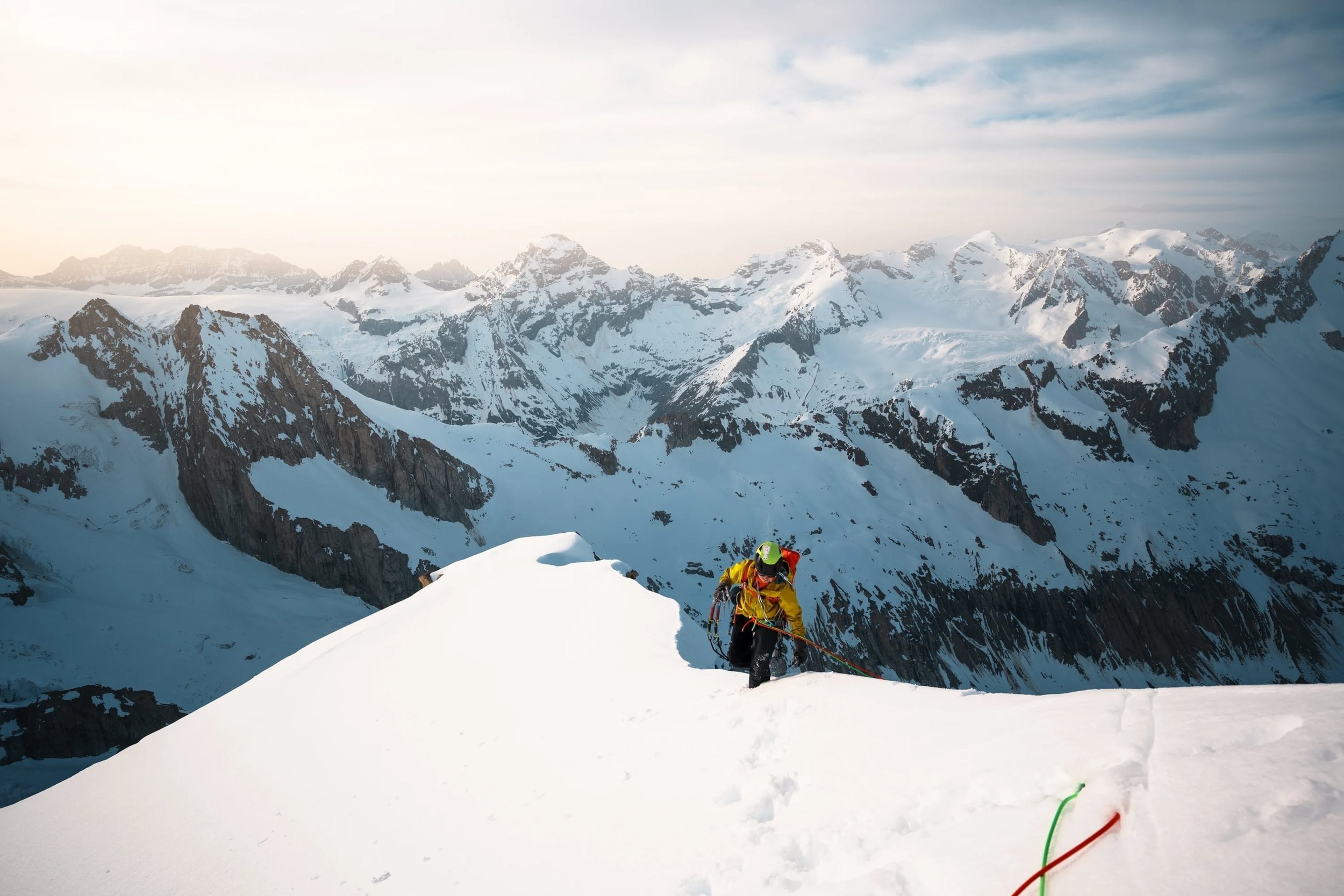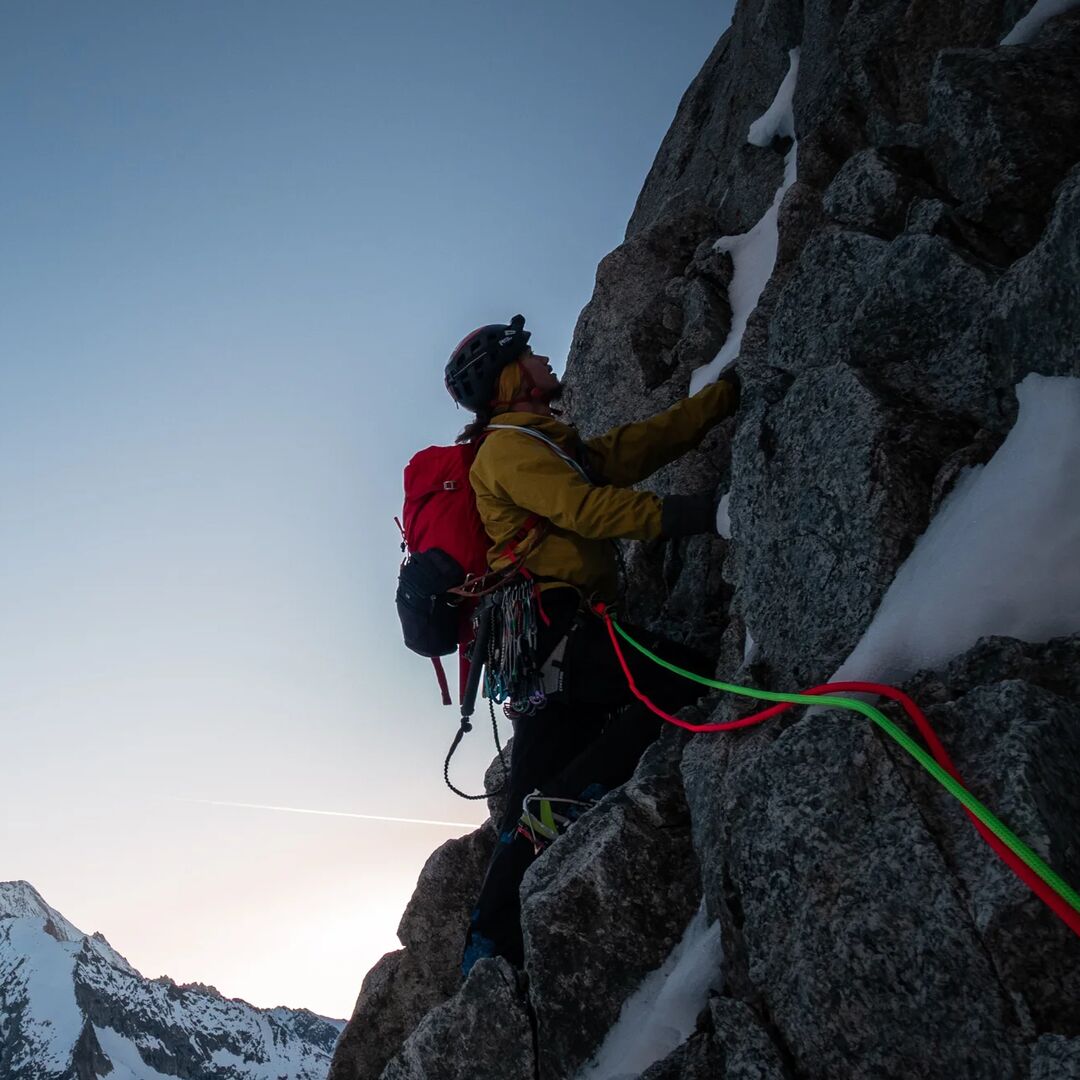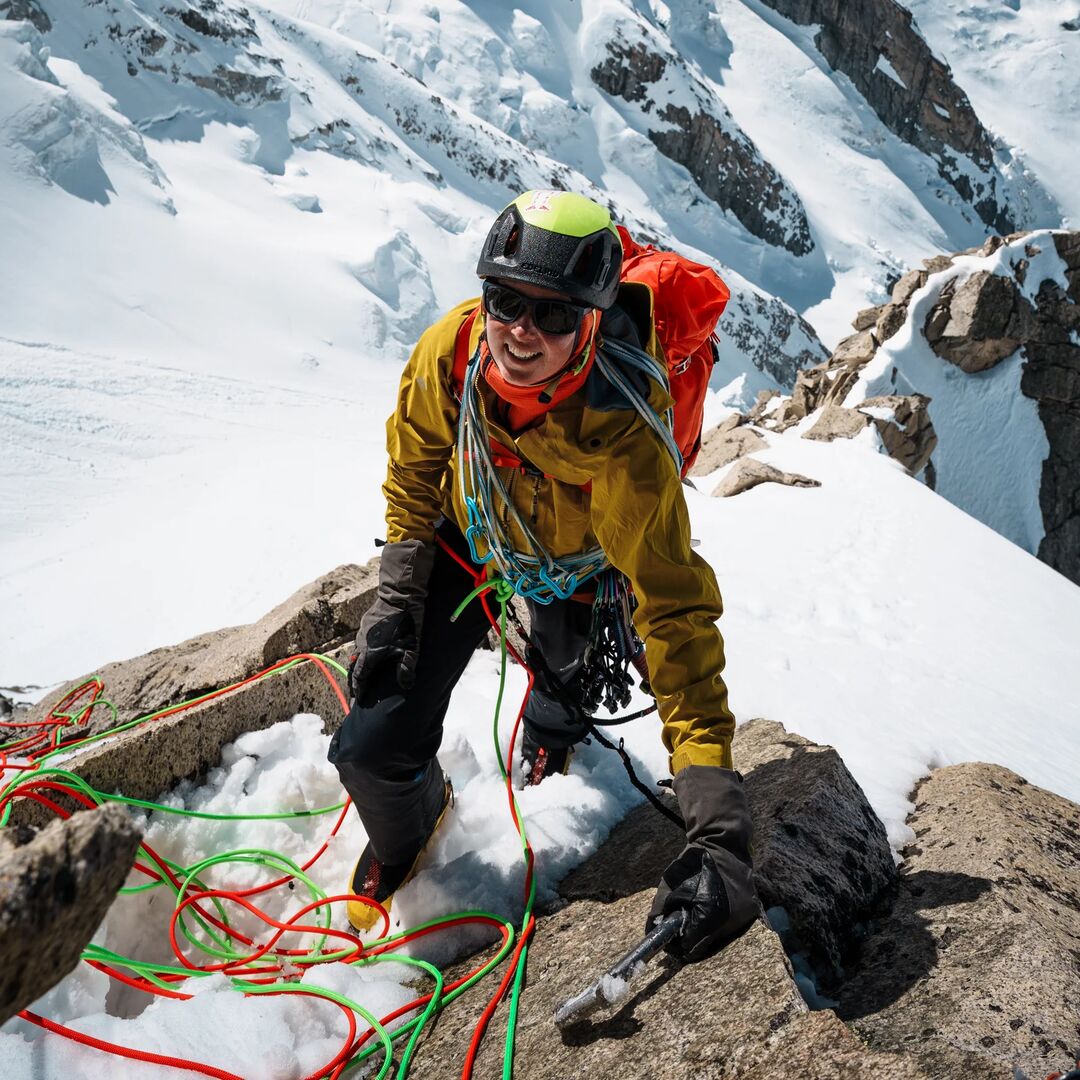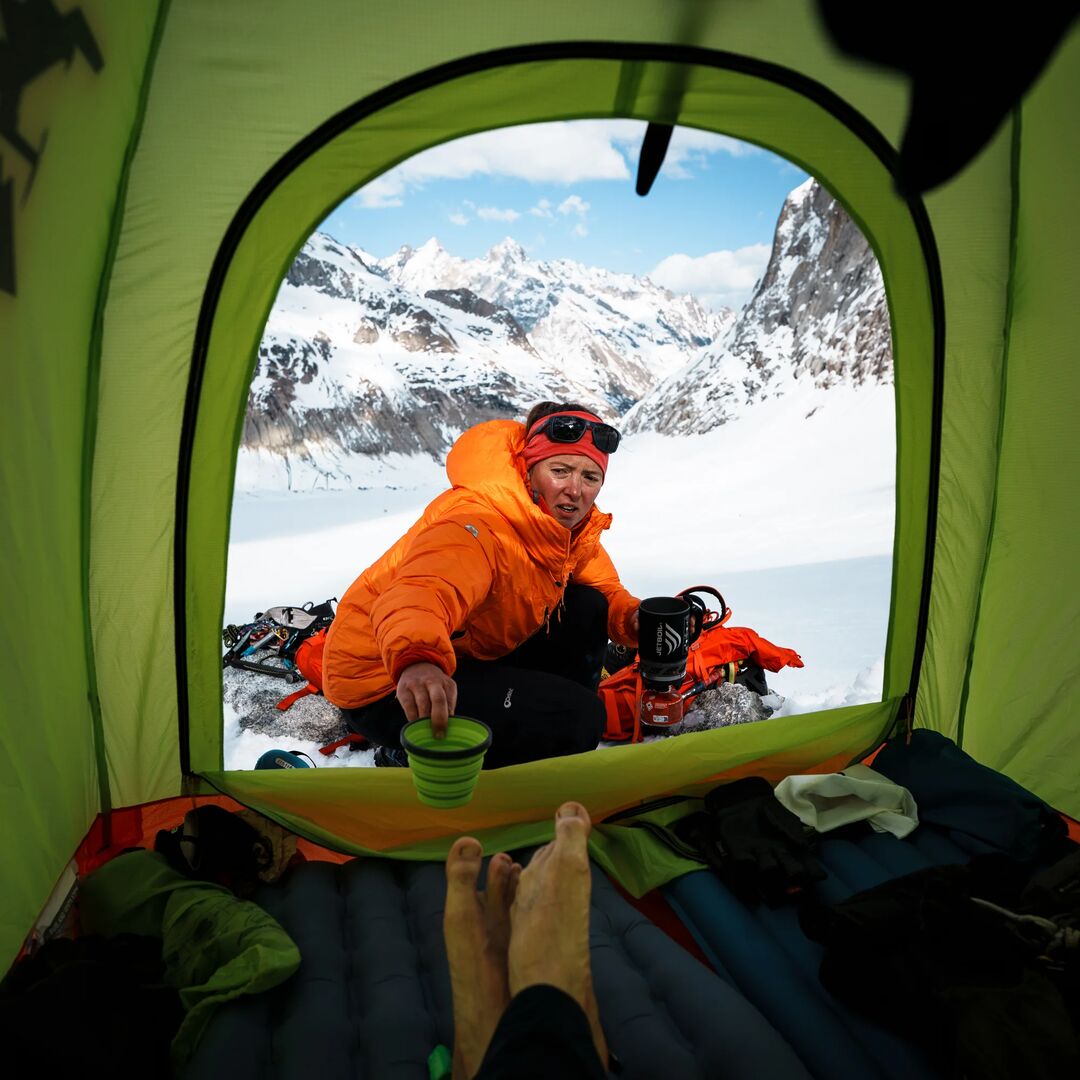“Nesthäkchen”, Nesthorn NNW pillar
- Our Team & Partners

Silvan and Doro Metz recently made the first ascent of “Nesthäkchen” on the Nesthorn NNW pillar, a great line hidden in a remote corner of the Bernese Alps. With difficulties up to M5+, WI4, 60°, it was a real alpine adventure in dramatic surroundings.
Words and photos by Silvan Metz
In 2016, I was at the Nesthorn for the first time. The tour over the right spur of P.3440 and the long descent over the Beich Glacier remains deep in my memory. Was it the 22 hours from the Oberaletsch hut to the car park? Or the wild landscape full of large glacier streams and steep granite spires?

Even then, I was fascinated by the hidden north face. "Welzenbach's hardest" is quite a statement. But then, as now, the idea of climbing under a huge serac all day wasn't particularly appealing. Maybe on the granite spires to the left and right of it? I took a few photos, but I wouldn't see the Nesthorn again for a while. In 2023, during the Fußhorn traverse, the shapely summit shone like an invitation in the first morning light. But as so often, plans remained plans and ideas remained ideas. Only when Silvan Schüpbach, Peter Von Känel, and Carlos Molina opened the "Kuckucksnest" on the NNW pillar in February 2025 did I really get the urge.
At the beginning of May, we’re standing in the car park and asking ourselves why we even brought skis: there isn’t a bit of snow in sight that could simplify the approach. We’re also too lazy to deal with the shoulder-season timetable of the Belalp lift, so we drag ourselves through the already green mountain forest. Our backpacks are heavily packed, full of climbing and avalanche gear, bivy equipment, food, and of course, skis and ski boots. The landscape already feels almost summery; only at the tongue of the dying Oberaletsch Glacier do we find remnants of white.


The Nesthorn is extremely remote, in the very back basin of the Beich Glacier, a tributary of the Oberaletsch Glacier. A solid eight kilometres of glacier highway to the base of the wall. For me, the remoteness makes the Nesthorn very appealing, but right now, being roasted by the sun between endless moraine ridges, the cable cars of Chamonix look rather attractive.
At the confluence of the Beich and Oberaletsch Glaciers, not only does the mighty Aletschhorn appear, but we also see the Nesthorn for the first time. Though still from the wrong side. It takes another two hours before we stand beneath the NNW pillar. We decided to pitch our tent on a small rocky island on the broad glacier stream. That way we can calmly study our intended line and won’t have to cross under a big serac during the descent. The 150 meters to the base of the wall should be frozen in the morning and manageable on foot, we think.


Set up the tent, melt snow, sort climbing gear. After the routines of alpinism, we go to bed early. At 3:15 a.m., the alarm goes off, and at 4:00 a.m., we set off. A bad omen appears shortly after: the snow has been perfectly frozen, but unfortunately, that’s no help if the high-standing May sun at the foot of the wall has only turned the uppermost centimetres into firn. Underneath, it’s bottomless sugary snow. What does that mean for the snowfields on our route? Never mind, we’ll see later.
The bergschrund is no problem. On the first pitches, we want to follow a faintly formed gully and hope for ice. In the first pitches, we are not disappointed. But as the gully steepens, two overhanging steps start to look suspiciously like snow mushrooms instead of ice. I decide instead to climb left of the gully over perfect rock. That turns out to be the right decision, and on the next pitch I can traverse back into the ice-filled couloir. Unfortunately, the joy is short-lived. On the next step, I find only thin, detached glazes on blank granite slabs. The last piece of protection is far below me. After some back-and-forth I manage to hammer in two small peckers in tiny crack traces. The pecker tips go only one centimeter into the granite, but it has to be enough. As if that weren’t enough, the powder snow hides all belay options. We have to simul-climb 10 meters until I finally find a crack for a green Totem. “On Belay!”


We have little desire to repeat that, and the thin ice continuing up the gully looks like it’s about to make things even worse. Instead, we climb rightward through an overhanging corner with a perfect hooking crack. Now we have to decide: we had actually planned to climb directly to P.3404 via a sequence of snowfields, but the snow lies only loosely on endless granite slabs. To the right, we could go around the pillar’s edge into the NW face, but we have no idea if it continues there. A level of uncertainty that gives first ascents their appeal. Hesitantly, I peek around the corner. I can’t see far, but at least the weathered granite is much more climber-friendly here. Even on the next, easier pitch, the view in the convex wall only extends a short distance. Maybe we can sneak up to P.3404, where we’d meet the historic route? But the next glance around the corner shatters that hope: just a sea of granite. Climbable everywhere, but time-consuming, and orientation is only possible by gut feeling. In a race against the sun, I scratch my way up thin glazes and after exactly 60 meters, find a place to belay. The wall opens into a basin; I instinctively follow the left passage, and after 130 meters of simul-climbing, we are on the NNW pillar route of Kirkpatrick and Hope.
Even though the route was established in 1905, we’re far from finished here. The first pitch still logically follows the pillar’s edge, then a block blocks the way. Silvan reported that during the first ascent of the Kuckucksnest, Peter, Carlos, and he always climbed east of the ridge crest. But the rock drops vertically into nothingness, the west side looks more inviting instead. At least until the next jagged section of the NNW ridge. So we follow the sunny rock for a while, until I reach an impassable gendarme and climb back to the ridge crest. And there, a hidden ledge leads back onto the shady NE side! From then on, we stay just below the sharp granite teeth, following what, in better conditions, would be simple firn bands. But the loose powder snow on the granite slabs still doesn’t want to let us go, so the climbing remains time-consuming. Only one short gully surprises us with perfect Styrofoam snow; then comes more sugary snow, until we finally reach the summit ridge. Doro breaks trail for the last 120 vertical meters to the summit while the sun is already setting behind the beautiful Breithorn.

The descent is, thankfully, tracked. Even through the steep eastern glacier arm, we can follow three ski tracks and find the way through a huge bergschrund on the first try. I break through into a crevasse up to my hips three times; then we reach the tent, completely exhausted.
The next day brings, as predicted, dreary weather. We stuff our backpacks full again until the seams burst and ski down the long glacier in a drizzle. When we reach the end moraine, a short sunbeam appears, only to immediately give way to steady rain. Soaking wet, the climb back up to Belalp is even less fun than it would be with just a heavy backpack, who would’ve thought...


Facts "Nesthäkchen":
660 m to P.3404, a further 440 m via the NNW ridge to the snow ridge. 900 vertical meters.
M5+, WI4, 60°
Gear:
- 60 m half ropes
- Double rack of Totems 0.2–2
- 3-4 peckers
- 2 knifeblade pitons
- 6 quickdraws
- 4-5 120 cm slings
- Cordelette for the belays








